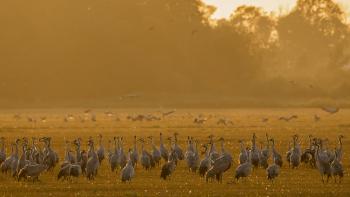In recent years nesting greylag geese, along with the number of geese and cranes on passage has increased significantly in Kvismaren. The first species reaching large numbers during migration was bean geese in the early 1980's. The geese that stop over in Kvismaren are mainly taiga bean geese and are in the area from September to November. Then they fly south to their wintering grounds in Scania and Denmark and then return to their major stop over sites between February and March before they move on, to Finland and Russia. Greylag Geese breed in the lakes and the number has steadily increased to between 200 and 300 at present.
The number of cranes has primarily increased during the autumn and now, the cranes’ stop over is a fantastic sight in Kvismaren. Increasing number of cranes also stay in the area throughout the summer. This is a phenomenon that also started in the last decades.
Over the years, the increasing numbers of geese and cranes has caused problems for farmers with damage to crops and fields as a result. Early on, several studies in collaboration with the County Administrative Board of Örebro were undertaken, to see which fields had the biggest problems with the birds and how extensive the damage was. We determined quite early that the damages in the spring, mainly occurs in autumn-sown fields. The spring-sown is mainly quackgrass which is food for the geese. In summer, a relatively small number of greylag geese and cranes can cause great damage especially to potatoes.
Methods of intimidation have been used to discourage the birds from sown fields and in recent years supplementary feeding on a special site that attracts cranes is a way to reduce the damages caused. In the autumn however, the birds prefer stubble fields with left behind seeds. To plow immediately after harvest is then inappropriate. Instead it is best that land owners make a late autumn or spring plowing. It took several years before the farmers acted on this. Once the change occurred, there was an immediate impact and reduced crop damages were significant in the following autumn. A means of crop protection is also hunting, which probably led to some geese starting to use other stop over sites rather than Kvismaren.
The cranes have been studied intensively by the Swedish Wildlife Damage Centre in Grimsö because they are a protected species. Birds have been equipped with transmitters their movements can be followed from nesting sites to Kvismaren and further in the area. The long term aim is to find the cause of the increasing population of cranes and the populations found within Kvismaren. The cranes that stay in Kvismaren mainly breed in Västmanland.
Kvismare Bird Observatory’s view and what we work for has always been the importance of studies and we have participated greatly in efforts to identify geese and cranes' movements. We are of the opinion that “with studies and adaptation of agriculture, the damages caused can be greatly reduced.”
